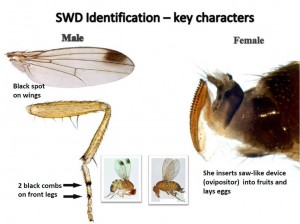
As we have seen over the past 3 years, this period of warm weather during the month of August gives rise to multiple overlapping generations of the adult Spotted Wing Drosophila (SWD), Drosophila suzukii. The increase in numbers has now been accompanied by significant raspberry, blackberry and late blueberry injury.
Introduction: Spotted Wing Drosophila, Drosophila suzukii (SWD) is a vinegar fly native to East Asia. Established in the Eastern US since 2012, it has become an invasive insect pest of small fruit and to a lesser degree, cherry and grape. Information on insect biology is located here..
Many growers that have not been monitoring or actively managing for this pest may be unaware of its presence in the crop. If fruit is softer than expected, discolored, with droplets of sap within the berry, it is quite likely the crop is infested.
A salt test is strongly recommended if you question the presence of the insect in the crop. Testing prior to harvest will assist you in determining if your protective measures are effective or if you need to modify the program. For instructions on how to conduct a salt test, read on.
Fruit injury over the past week has ranged from 2% to 100% damaged fruit beginning with egg laying across much of the Hudson Valley. Until recently, due to a significant delay in SWD appearance into the region, berry patches have been lightly managed to this point. However, larva are beginning to cause significant injury to fruit as extensive fruit feeding is coupled with very high egg laying and soaring adult populations. 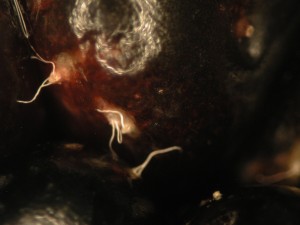
As raspberry and blackberry are the favored host of the SWD, relative to blueberry and strawberry, these commodities will require intensive management strategies over the next few weeks through frost.
In raspberry or blackberry patches where SWD have been captured and or fruit injury has been observed, management should begin at the first available application window to reduce adult populations and egg laying. In these cultivars a tight management schedule of 3-4 days may be needed if populations continue to increase (very likely). Blueberry have been successfully managed with a 7-day program.
If periods of rainfall begin, insecticide residue will quickly be removed and re-application should be made at the first available spray window. 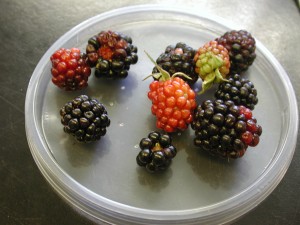
2012-15 Lessons:
A Hudson Valley fruit grower was able to retain a clean crop (0% fruit injury) using a 3-4d program on raspberry. After 6 days of intermittent rainfall, an assessment of the crop on day 6 of raspberry showed 40% injury to the crop. With an aggressive response, this grower was able to reduce the damage down to 14% by week two through re-establishment of his management program and clean picking the crop weekly. However, this level of damage to the crop remained until the end of the season even with a very tight program.
Monitoring: To date, SWD have been captured in all Hudson Valley counties where monitoring has been taking place, including Westchester, Dutchess and Ulster in raspberry, blueberry and blackberry plantings.
Traps we are presently using are made of red plastic 16 oz. solo cups and lids with a black band of electrical tape. Traps are baited with apple cider vinegar (ACV), as the attractant killing solution. Approximately 30, 1/8″ holes, are drilled around the top 3/4 of the cup, leaving a 3′ gap to pour out the ACV solution in a strip of 2″ x 2″ netting to access the number of captured flies. A yeast, flour & sugar bait mixed with water is added to a 5 oz. fixed position cup along the top edge. 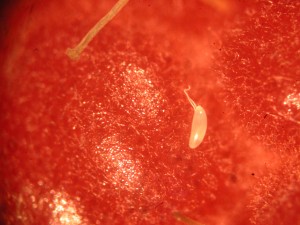
Given the increasing number of SWD finds we are seeing in the northeast, it would be wise to begin trapping efforts in brambles and blueberry fields as flies increase from localized to regional populations. 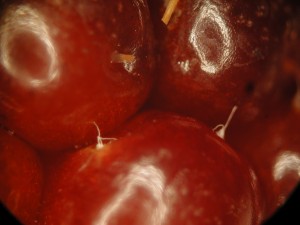
Larva in MY fruit? Another option to determine SWD presence would be the use of a rapid determination of the presence of larvae in fresh blackberries or raspberries. Creating a salt solution made by dissolving 1 to 2 Tsps. of salt in 1 cup of water. Collect a representative sample of fruit and begin by lightly crushing the berries and submerging them in the salt solution for about 10 to 15 minutes. If larvae are present in the fruit, they will crawl from the berry through the oviposition site and be visible emerging from the berries without the help of hand lenses.
Conventional and Organic Management Options for NYS grown small fruit: Insecticides labeled in NYS to manage SWD
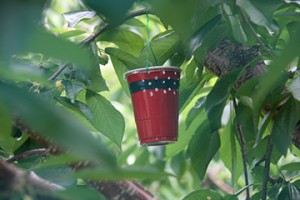
The Cornell Spotted Wing Drosophila web site hosts a map of the counties in which SWD is being trapped. Updates on presence based on trap findings can be found here.

